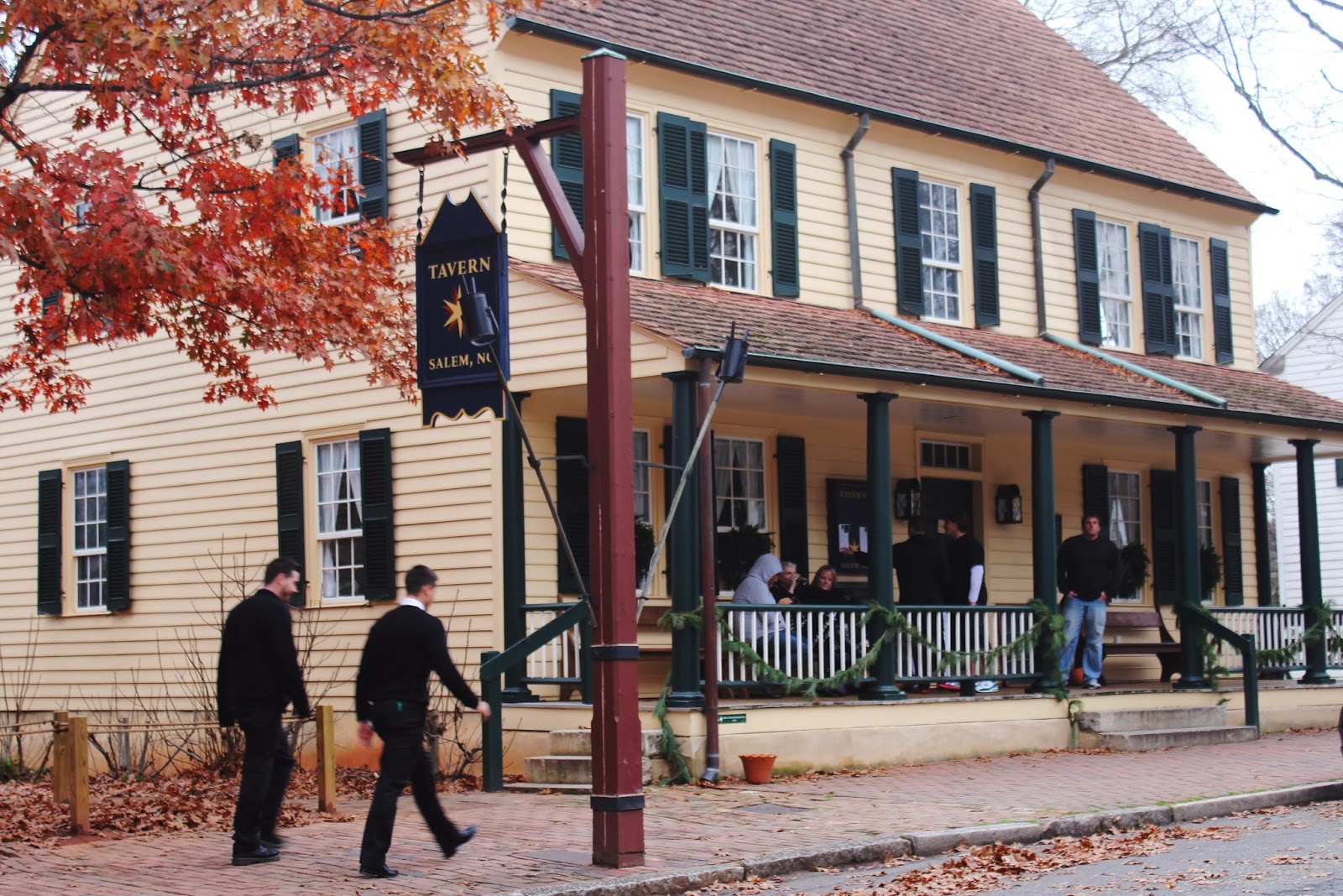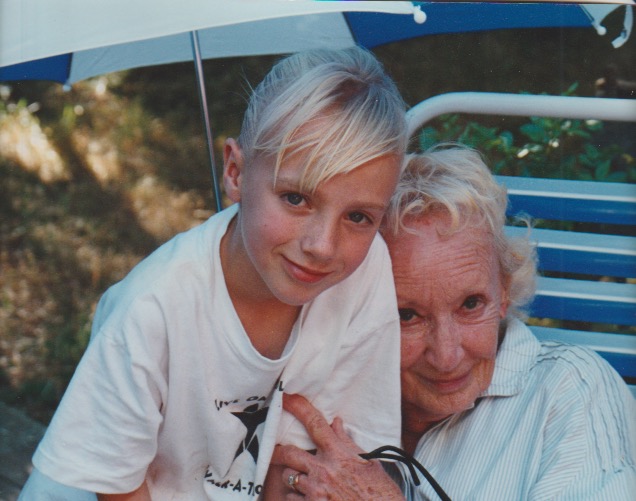TIME TRAVELERS: A WINTER RESPITE IN OLD SALEM
 |
| Winter greenery in Old Salem |
With the semester ended I contemplated a weekend free of work
for the first time in four months, and made plans to unwind in Hendersonville at
a Christmas fair. My husband, however,
still faced two more weeks of classes and final exams, so I deferred to his need
to spend a restorative day in the eighteenth century. We headed northeast to Old Salem.
Old Salem in North Carolina should
not be confused with Salem, Massachusetts, the New England village where
nineteen people were tried and hanged as witches in 1692-93. The Carolina settlement was founded nearly
one hundred years later by Moravians, a protestant sect of industrious Germans who
relocated to the southern wilderness from Pennsylvania. Like the Shakers, these Moravians were people
of strong faith who practiced a form of communal living and were extremely
talented builders and craftsmen.
 |
| Herbs and vegetables on West Street |
The
proof of that is in the ninety-one original buildings dating from 1766 to 1860
surviving in Old Salem to this day.
These include the circa 1769 Single Brothers House, a kind of
dormitory/carpentry-shop where unmarried men lived while they learned a trade;
the Salem Tavern, where visitors still dine on bratwurst and beer as George
Washington did when he stayed there in 1791; and the tall-spired Home Moravian
Church, where an active congregation has been worshipping in the same sanctuary
since 1800.
 |
| Home Moravian Church |
The historic district of Old Salem
occupies roughly twenty blocks in the heart of Winston-Salem, the rough-edged
tobacco town that grew around it, with some restored residences privately owned
and others open to the public. Upon
crossing the covered bridge into the village one steps into a world measured by
the clip-clop of carriage horses on cobblestones and an occasional bell toll
from the church. It’s like a spa-day for
your spirit.
We have been here numerous times over the last two decades:
with my daughter when she was a schoolgirl and craved the cinnamon-scented
sugar cake at Winkler’s Bakery; with visiting relatives who took in the
exhibits at the Horton Museum, principally the treasures displayed in the
period interiors at the Museum of Early Southern Decorative Arts (MESDA); and with
gardening friends who delighted in the restored organic kitchen gardens, grape
arbors and heirloom apple trees arrayed along Salt Street. Now that we’re empty-nesters we prefer to visit
this Colonial enclave in the quieter, less crowded seasons of autumn and
winter.
 |
| Sugar Cakes for sale at the Winkler Bakery |
On the first Saturday in December we were too late for the flaming gold display of the sugar maples, and the gardens had mostly been put to bed except for some plots of collards and cabbages. But there are plenty of indoor attractions at Old Salem.
 |
| The Tavern in Old Salem |
While waiting for a table at The Tavern, we browsed at T.
Bagge, the gardening store on Main Street.
They drew me in with mason bee-houses, South Carolina gardening guides
and organizers for my potting shed. I happily
snagged the last bag of summer snowflake bulbs on discount, Leucojum aestivum. These starry
perennials are Dixie’s answer to British snowdrops (Galanthus spp.), which fail to thrive in our clay soil. Despite their common name, summer snowflakes
bloom in early spring in Zone 7B, and naturalize so easily in our region that
their white fairy-bell blossoms etched with green are often seen blooming in
the gardens of derelict homes long after the gardeners have moved on.
 |
| Summer snowflake bulbs |
 |
| Musicians on the Square |
Summoned for lunch at
The Tavern, we dared not linger on Salem Square long enough to hear the
musicians play more than two bars of “The Coventry Carol.” Settled out of the wind in one of the cleanly
proportioned rooms on the ground floor, we dined on meatloaf, pot roast and hot
German potato salad washed down with Spaten lager on draft. This is hardly typical fare for us, but for my
husband, whose youth was spent stationed with the Army in Germany, the Tavern’s
stick-to-your ribs menu represents the ultimate comfort food.
 |
| Eating at The Tavern: a hot meal on a cold day |
Well-fueled, we were ready for a walk, popping first into the
A. Butner Hat Shop to try on the hand-made period hats (note to reenactors: check
out the ‘Colonel Mosby,’ a beautifully re-created felt slouch hat identical to
the one worn by Confederate cavalry officer John Singleton Mosby, the “Gray
Ghost”). We continued climbing Academy
Street to the church and circled Salem College, where the strains of the horn
players’ music drifted up to us. Crossing Bank Street, we admired the
cold-season row crops planted opposite Dr. Vierling’s house and the new
beehives sited in a private garden adjacent to God’s Acre, Salem’s cemetery.
One of the key factors in keeping Salem a viable community as
opposed to a theme park is the mixture of public attractions and privately
owned homes. This ratio seems fairly
fluid, with some homes we’ve visited in the past changing hands and becoming
private, while others renovate and open for business, like the Augustus T.
Zeveley Inn, a bed-and-breakfast on Walnut and Main Streets.
 |
| A. Butner Hat Shop |
There are
always one or two houses for sale in Old Salem, some of which are listed with the
non-profit organization, Preservation North Carolina. On this trip we noted two homes for sale in
the heart of the old district which I looked up later on the PNC website. The Timothy Vogler house is just about the
right size for us, but all that history comes at a steep price. Whenever FK and I fantasize about the
prospect of living in such a place we end up consoling ourselves for its being
unattainable by imagining the restrictive covenants that would go along with
owning a property in the midst of an historic tourist attraction, as in ‘and we
thought having an HOA was a headache!’...
 |
| A garden of cabbage, collards and broccoli. Vierling House, 1802, in background. |
The gray western
horizon is tinged with pink as we finish our rambling. We duck back into the garden shop long enough
to select a cedar wreath for our door and make our way to the covered bridge
that carries visitors over Liberty Street to the Visitor’s Center. On the other side lies the 21st
century.
A young
family is taking pictures on the bridge, and as we approach, the grandfather
calls to them to finish up. FK shakes
his head. Take your time, he tells
them. We’re in no hurry to cross over.
####
Old Salem is located at 600 S. Main Street in Winston Salem,
NC. Hours of operation are
Tues-Saturday, 9-5, and Sunday, 12:30-5.
There is no fee to eat at the restaurants (in addition to The Tavern,
there is a sandwich shop located above Winkler’s Bakery) or to enter the shops,
but you will need to purchase an admission ticket at the Visitor’s Center in
order to enter the historic buildings in the village where demonstrations and
tours take place. For more information,
call 336-721-7300.
Reservations are strongly recommended for lunch at The
Tavern – call ahead at 336-722-1227. To
see a menu, follow the links on the website for old Salem.
Preservation North Carolina is an historic preservation
organization whose mission is to protect and promote buildings, landscapes and
sites important to the diverse heritage of North Carolina. Visit their website to see what historic
properties are for sale statewide.



Comments
Post a Comment
Thanks for dropping by!